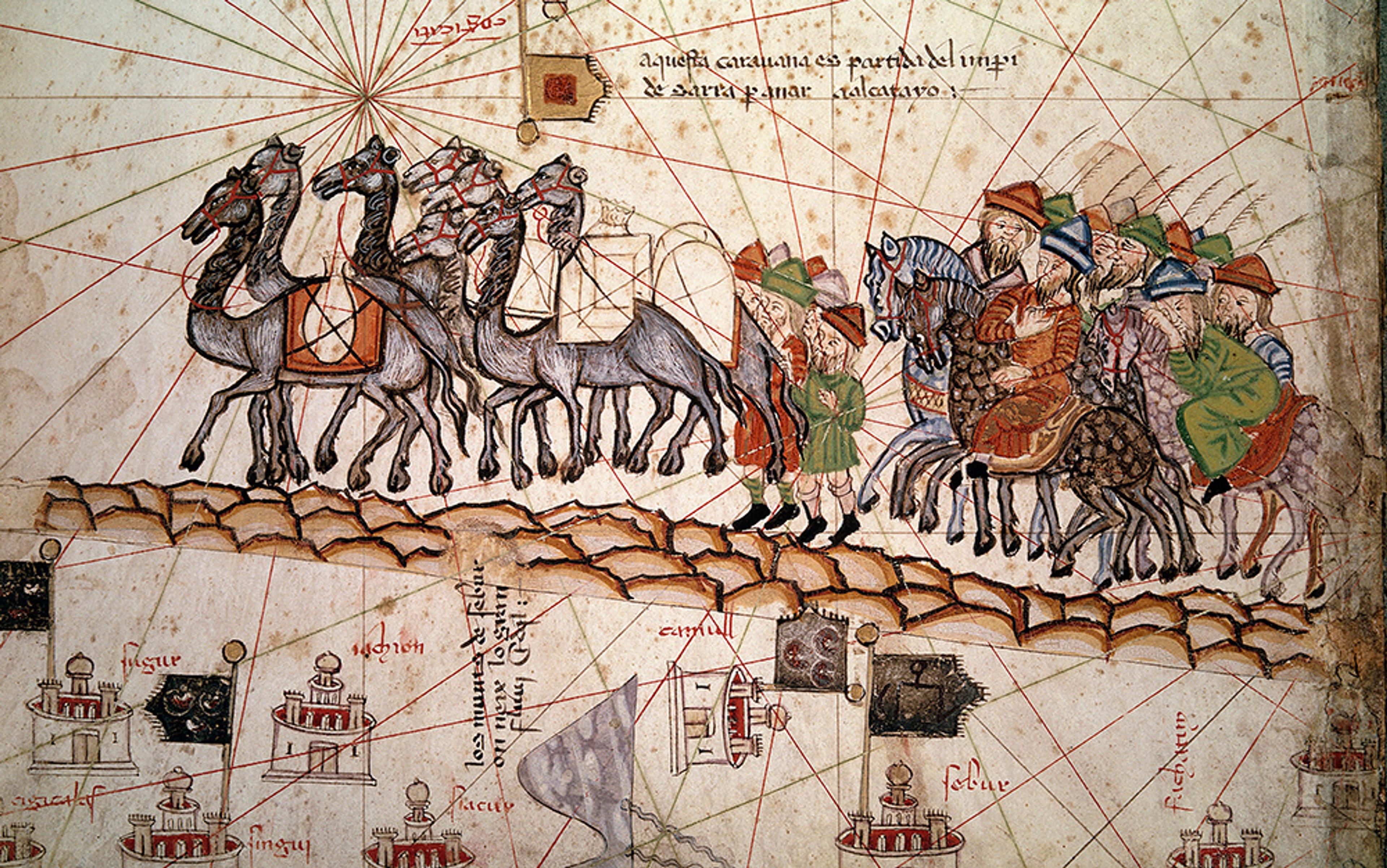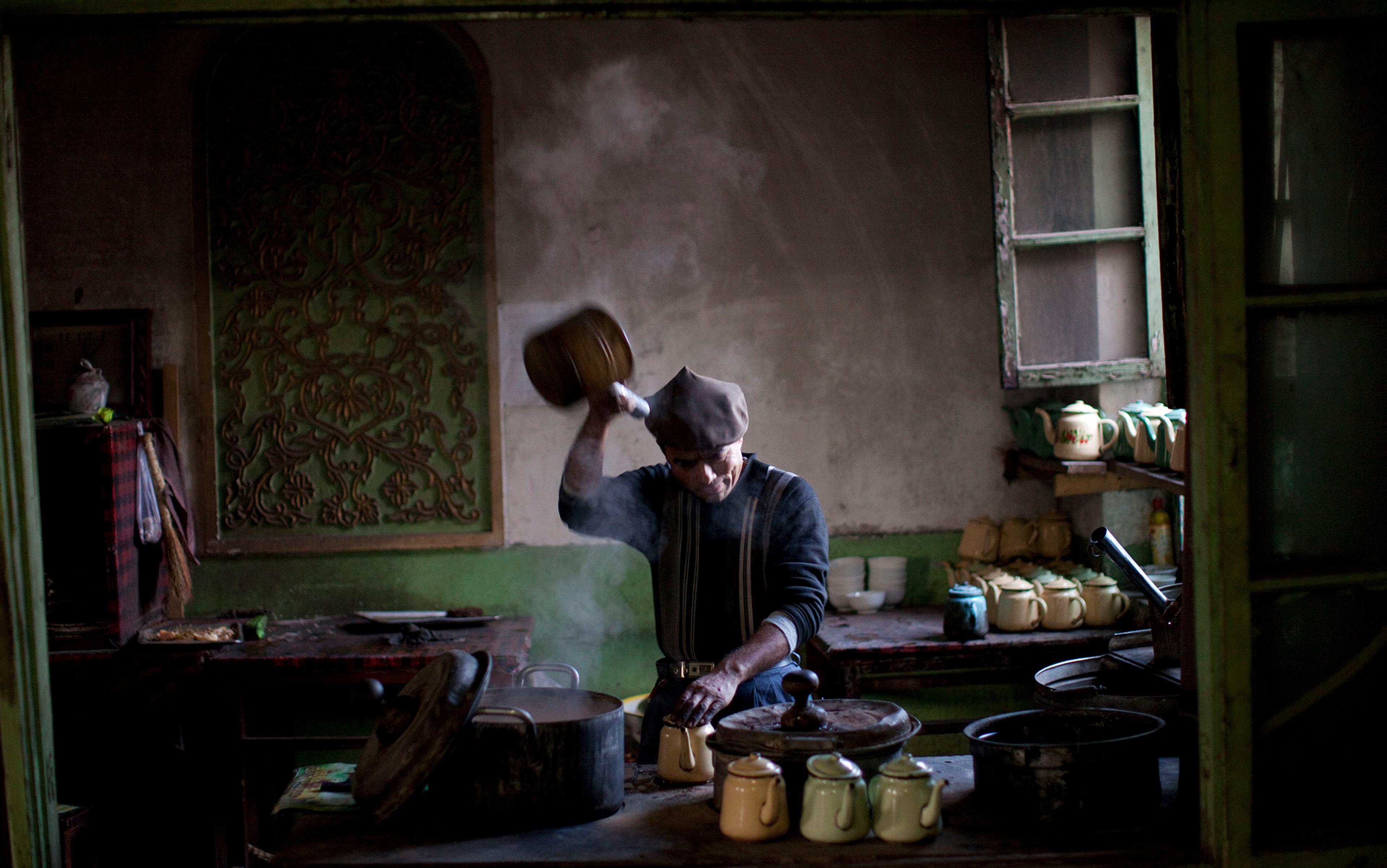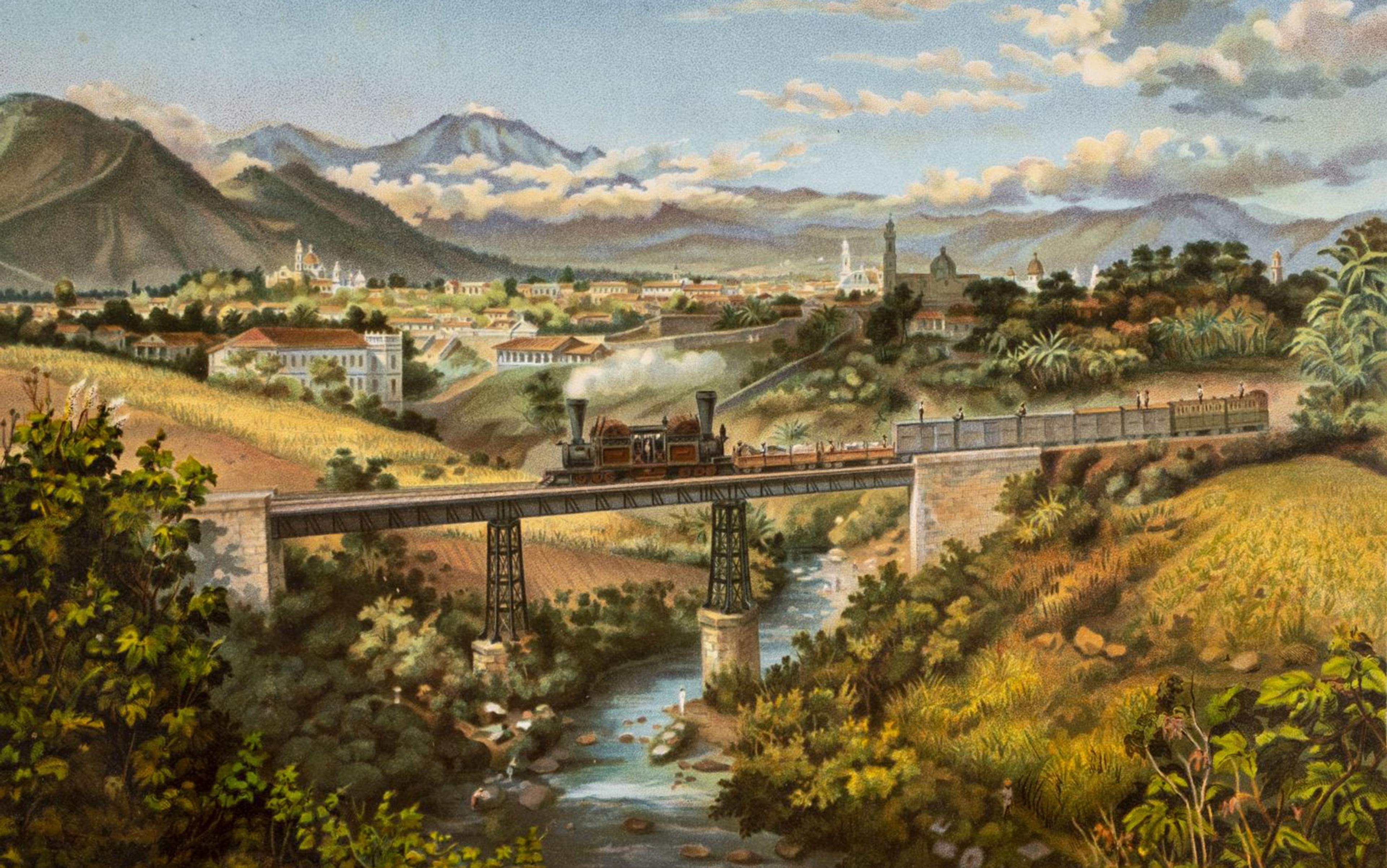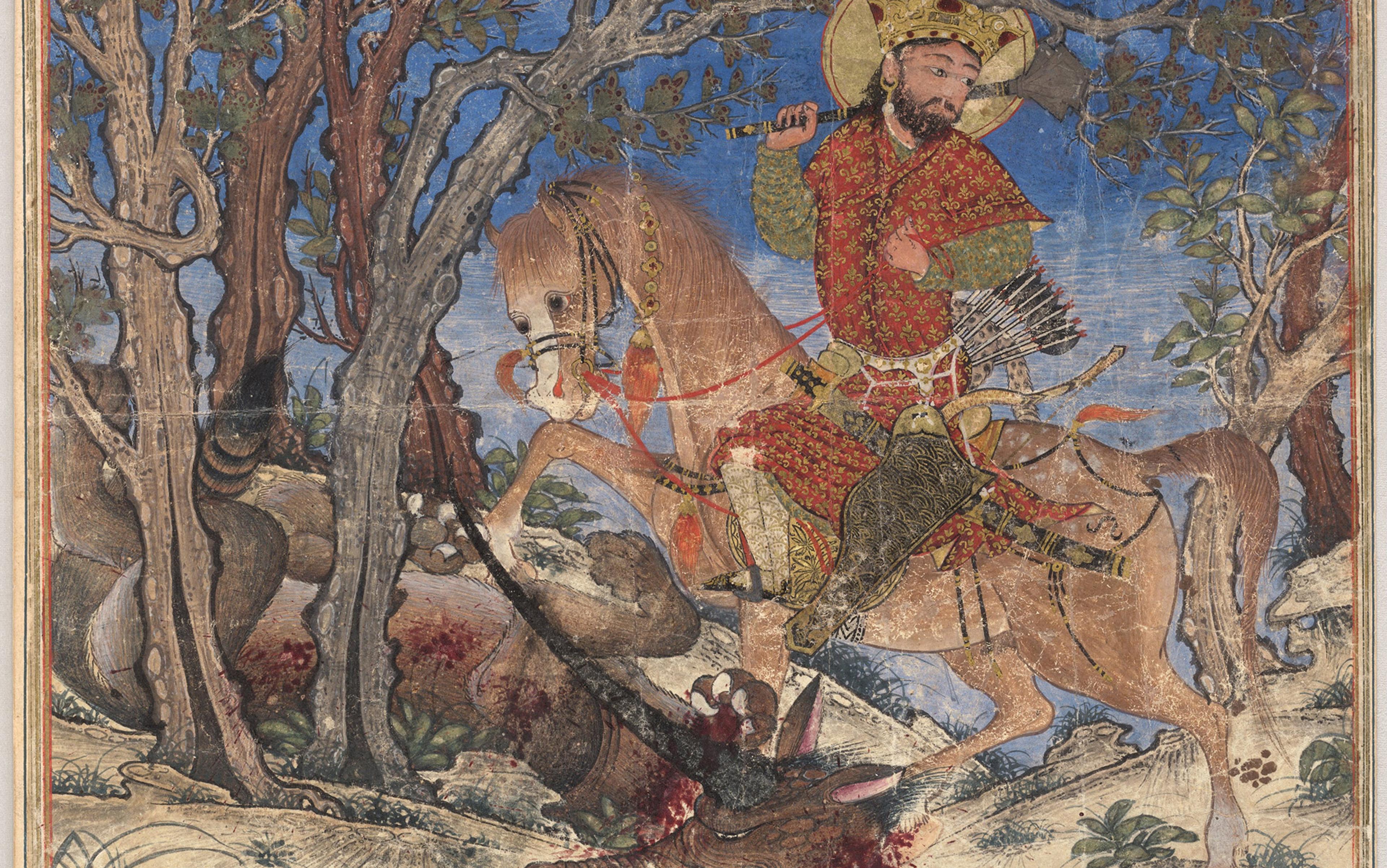Successful empires and kingdoms are good at building infrastructure and sharpening the best ideas. The inscription along the magnificent colonnade above the James A Farley building in central Manhattan, the largest post office in the United States, reads: ‘Neither snow nor rain nor heat nor gloom of night stays these couriers from the swift completion of their appointed rounds.’ Herodotus wrote the words 2,500 years ago, to describe the ancient Persians – who were always on the lookout for innovative technologies and ideas that made it easier to administer their great empire. Getting messages quickly and reliably from A to B in the ancient world was no less important than it is today.
The instant communications made possible by recent technological changes should not make us susceptible to the breathless commentary about globalisation as something new. For more than two millennia, news and information, goods and products, ideas and beliefs have flowed through networks linking the Pacific coast of China with the Atlantic coasts of North Africa and Europe, the Indian Ocean and the Persian Gulf with the Mediterranean and Scandinavia. Since the late 19th century, these networks have been known as the Silk Roads.
For most, the name conjures an exotic air of a distant past, but not a history. The history of ideas has not admitted the Silk Roads as it links past to present in a chain from polytheism and democracy in Ancient Greece to the arrival of Christianity in Europe, which led to the Renaissance, paving the way for the Enlightenment. The Enlightenment gave birth to political democracy and the industrial revolution, the logical culmination of which is the US and its creed of life, liberty and the pursuit of happiness. Historians challenge and reshape individual sections of this story; but its essential components and trajectory remain secure.
If history, as the saying goes, is written by the winners, it might be why the world, especially the world from the Eastern Mediterranean to the Pacific Ocean seems so unsettlingly difficult to understand.
It is no coincidence that the lion’s share of challenges and opportunities around us narrow down to the old Silk Road. We are witnessing the world’s centre of gravity return to the axis on which it spun for millennia. When viewed from the vantage point of the Silk Roads, the familiar narrative begins to quiver, history itself begins to shift. In fact, to understand the world, the best place to look is not in the centre of the West nor in the heart of the East, but on the old Silk Road where the two come together.
The world’s great religions burst into life in Uzbekistan, Kazakhstan, Turkmenistan, as well as Iran, Iraq, southern Russia and the countries of the Levant and the Caucasus. Here Judaism, Christianity, Islam, Buddhism and Hinduism jostled, borrowed and competed with each other. It is here where language groups collided, where Indo-European, Semitic and Sino-Tibetan tongues wagged alongside those speaking Altaic, Turkic and Caucasian. Great empires rose and fell here, and the ripple effects were felt thousands of miles away.
The nations of the Silk Roads are sometimes called ‘developing countries’, but they are actually some of the world’s most highly developed countries, the very crossroads of civilisation, in advanced states of disrepair. These countries lie at the centre of global affairs: they have since the beginning of history. Running across the spine of Asia, they form a web of connections fanning out in every direction, routes along which pilgrims and warriors, nomads and merchants have travelled, goods and produce have been bought and sold, and ideas exchanged, adapted and refined. They have carried not only prosperity, but also death and violence, disease and disaster.
The Silk Roads are the world’s central nervous system, connecting otherwise far-flung peoples and places. These networks are invisible to the naked eye – just as the body’s veins and arteries lie beneath the skin. Understanding the Silk Road and its connections provides an essential corrective to established narratives of the past, and more. Understanding central Asia’s role helps developments make more sense not only across Asia but in Europe, the Americas and Africa. It allows us to see patterns and links, causes and effects that remain invisible if one looks only at Europe, or North America.

Most scholars have neglected these networks for three reasons. First, they challenge the familiar, triumphalist story of the rise of the West. Second, historians today work in crowded and competitive fields requiring increasingly narrow and precise specialisations. To say something new means opening a new field of investigation – which requires turning over a small stone, previously assumed to be unimportant, and assessing what lies beneath. Revolutionising history on a grand scale calls for a braver and more ambitious approach.
Finally, there’s the simple fact that Western scholars’ ability to follow historical connections can be limited by the lack of knowledge of central Asian languages. Few students (and scholars) are able to read languages of the East in combinations that allow grand exchanges to be studied in primary sources. For those lucky enough to be able to study classical languages, Latin is the cornerstone; Greek is taken by a tiny number of students, which means that the crown jewels of the past lie ignored and undisturbed. Medieval Greek literature – such as histories by Procopius, Anna Komnene or George Akropolites – are known to few modern Western scholars. Yet they are invaluable sources for the Byzantine empire, which flourished for a thousand years and is all but forgotten today.
Western scholarly knowledge fares even worse with the Slavonic world. Glorious works such as The Russian Primary Chronicle (850-1110) and The Chronicle of Novgorod (1016-1471) are all but unknown. The same is true of Arabic histories, poems and philosophical treatises, with the works of Muqaddasī, Ibn Faḍlān and Masūdī almost entirely overlooked. The great works of Persian poetry and prose – such as the epic Shāhnāma of Firdawsī or the Ta’rīx-i Jahān-Gušā of Juvaynī, which relates the history of the Mongols – remain a mystery, while texts in Tamil, Hindi, and Chinese – such as the Shi Ji, written more than two thousand years ago by Sima Qian – fare no better. And yet, as King Wu-Ling, ruler of the Zhao state in northern China and beyond more than two thousand years ago understood, it was important to keep up with the times: ‘[A] talent for following the ways of yesterday,’ he declared in 307 BC, ‘is not sufficient to improve the world of today.’ Our television adverts and commentators now constantly invoke the globalised state of the world. It is past time to rethink how we look at the past.
Europe was irrelevant to global history until around 1500 AD. For all the resources enlisted in studying Athenian democracy and Greek art and architecture, the Greeks themselves looked only to the East. For the ancient Greeks, there was one enemy: Persia. When Alexander the Great set out to conquer the world, there was no question which direction he would turn. He had no interest whatsoever in the Mediterranean and what is now Italy, France, Germany and Britain – countries whose built environments owe a great deal to the presumed link with antiquity. All that mattered was taking control of the networks weaving across Asia: the Silk Roads.
The same was true of Rome. Courses on Julius Caesar’s invasion of Britain, the Asterix comic books and the film Gladiator (2000) give the misimpression that Rome’s centre of gravity lay in Europe. Instead, Rome looked to Africa and Asia – above all to Egypt, where the rich banks of the Nile produced crops that could feed an empire, and on the trade routes through the Persian Gulf, across the Indian Ocean, and overland across Asia. So extensive were connections between Rome and the East that the coinage of local rulers in the Indus Valley was soon being re-fashioned to look like and have the same denominations as those in Rome itself.
Until at least 1300, there were more Christians in Asia than in Europe. Then, and again now, Christianity is an Asian religion
With peace and prosperity the staple of the empire, new elites began to satisfy their appetites for the fine things in life. None of them came from Europe. The luxuries that counted were all from the East, whether that meant spices and silks, or exotic sexual experiences. Not everyone approved. It was scandalous that women wore fabrics that showed their curves and left nothing to the imagination, wrote the prudish Seneca. Pliny lamented how much money was leaking out of the Roman economy – and into the hands of others, he noted: hundred of millions of sesterii, and all heading East. Recent coin finds suggest he was not far wrong.
Ideas flowed along the same trade routes as goods and commodities. Europeans think of Christianity as theirs, but the religion flowed out of Palestine once missionaries, after the time of Jesus, fanned out in all directions. In fact, Christianity spread quicker and took hold more effectively in Asia than in the Mediterranean and across Europe – not surprisingly, given that the religion was centred on Jerusalem and the Holy Land, and rose within the context and physical setting of the Middle East. Jesus’s teachings spread rapidly across Asia, quickly gaining followers as evangelists, preachers and merchants spread the message along the trade routes. It was not long before there were bishoprics dotted all over what is now Iran, Turkmenistan, Uzbekistan and even China – which had its first bishop in place before Britain. Until at least 1300, there were more Christians in Asia than in Europe. Then, and again now, Christianity is an Asian religion.
The rise of Islam in the seventh century brought change. The followers of Muhammad quickly recognised that the best path to conquest lay in securing the principal communication routes that crisscrossed Asia. The Arab armies proved singularly successful in taking control of these crucial networks, doing so first to protect existing gains, and then using them to fan out to extend their authority elsewhere. The first Muslims proved highly tolerant of other faiths, especially Christianity and Judaism, to the extent that Muhammad’s earliest successors not only took trouble to visit the Church of the Holy Sepulchre to pray at the site where Jesus Christ had been buried and rose from the dead, but they could also be found in tears when learning that Christians and Jews were converting to Islam. The first Muslims kept themselves to themselves, striking deals that guaranteed the safety of the ‘People of the Book’.
The early Muslim’s soft touch helps explain how they built a vast empire, spanning from Spain to the Himalayas, in just over half a century. The new world emerging in time became self-confident, tolerant – and extremely wealthy. Peace and prosperity brought economic growth as resources from all corners poured into the heart of the world. Trade flourished. Damascus (in modern Syria), Mosul and Samarra (in modern Iraq), Merv (modern Turkmenistan) and other cities boomed. A new capital was built as a trophy at the very centre of the mesh of connections, called the City of Peace. Today it is known as Baghdad.
Almost inconceivable wealth flowed into these cities. With no need to fund armies, expenditure went above all on luxuries. Central Asia, China, and India exported silks, ceramics, spices and textiles in vast quantities to keep up with the demands of the new rich. The appetites for luxuries catalysed a wave of advances in porcelain- and ceramics-production techniques. In China, kilns were developed in the 8th and 9th centuries that could fire 15,000 pieces at a time, all for export to the Persian Gulf and the cities of the Silk Roads.
But the profits made on the Silk Road were not all frittered away on whims and trophy assets. Funding flowed into the arts. From mosques to madrassas, from libraries to bathhouses, magnificent buildings arose. Scholars received patronage enabling extraordinary advances in sciences. Ibn Sīnā (better known as Avicenna), al-Bīrūnī, al-Khwārizmi and other scholars became giants of learning. A thousand years ago, the Oxfords and Cambridges, the Harvards and Yales were in Balkh, Bukhara, Herat and Samarkand, places now largely forgotten and confined to obscurity.
Human trafficking in the early Middle Ages was fundamental to the rise of the West
For a long time, much of Europe descended into a period so bleak it’s called the Dark Ages. For hundreds of years, little of note was produced. Europe was a cultural and intellectual backwater, a stagnation that perplexed Arabic writers. Once, the Greeks had been pioneers in mathematics, astronomy and science, they noted. Why had their intellectual life and scholarship all but collapsed? Some had little doubt what was to blame. The problem, suggested one Arab author, was religion. As soon as the Greeks and Romans had adopted Christianity, their appetite for knowledge had disappeared. Blind faith ‘effaced the signs of learning, eliminated its traces and destroyed its paths’. The fundamentalists were not Muslims, but Christians. The open, curious and generous were based in the East – not in Europe. As one author put it, when it came to writing about non-Islamic lands, ‘we did not enter them [in our book] because we see no use whatsoever in describing them’.
By the 9th century, Europe began to rise from the shadows. The stimulus came from the Silk Roads. An influx of silver from the East kick-started the European economies and prompted the development of distinctive and unique elite structures. Feudalism owed much to the way in which European societies controlled their assets – and to the ability of aristocrats to dominate the peasantry. The root cause of these techniques came from rising engagement with the wealth of the Arab world. Unable to offer much by way of trade, the Europeans turned to one plentiful commodity that could unlock waves of silver from the East: slaves. These were not brought from Africa, as happened after Columbus’s expeditions across the Atlantic, but from Ireland and Britain, and above all from the Slavonic populations of eastern and central Europe. Human trafficking in the early Middle Ages was fundamental to the rise of the West.
So too was the development of religious violence as a political tool. As is also obvious today, those who commit acts of terror while claiming to be doing God’s work find audiences equally receptive and horrified. This was nowhere better epitomised than by the Crusades, which saw large numbers of knights seeking to do their Christian duty, while at the same time doing well from establishing a colony to protect the Holy Land. Not all who took part were misty-eyed, or religiously minded. City states such as Pisa, Genoa and Venice kept a close eye on the bottom line, realising that there was much to be gained by securing a foothold in the Levant that gave them better access to the goods that were in growing demand back at home. Ultimately, devotion took second place to cold reality – for despite holding Jerusalem for the best part of a century, the Christians of Europe proved unwilling and unable to secure it properly, and withdrew from the Holy Land altogether. There were better and easier ways to tap into the Silk Roads than fighting for the benefits – as Marco Polo was quick to point out.
The burning desire to get closer to the source of India and China’s legendary riches spurred the age of European discovery. Christopher Columbus did not try to sail around the world to see if it was flat, or to find out what lay across a seemingly endless ocean: his journey intended to find a new route to Asia and a way to access trade networks that might bring untold riches to the rulers of Castille and Aragon in Spain. With Vasco da Gama setting out just five years later to achieve the same ends, the shape of the world changed dramatically: before the 1490s, countries such as Spain and Portugal, the Netherlands and Britain found themselves at the wrong end of the world; it was not long before they found themselves at its centre.
The rise of Western Europe into a group of powers controlling empires across the globe required multiple causes. These include increasing calorie consumption in different parts of the continent, fertility levels, environmental and climate change, sophistication of financial institutions and the exploitation of fortunate local circumstances. Importantly, however, the propensity for violence was also a key element to the success of Spain and Portugal, the Dutch Republic, France and Britain in ruling over land and sea. They refined their facility with violence in the incessant contest against one another for power within Europe. The rhythm of intra-European warfare was relentless, facilitating rapid advances in ballistics, firearms and weapons production. Not all the West’s conquests abroad resulted directly from the use of force: in some cases, such as in Bengal in the 1750s, local rulers hired Westerners as mercenaries, with disastrous long-term consequences when those recruited to help found it impossible to resist becoming masters.
The assassination of Franz Ferdinand in Sarajevo provided the spark; but the tinder had been laid in Asia
That changed the balance of the Silk Roads, for colonies were seen as soft centres that could provide cash back to the capitals of Europe. Some resisted violently – above all in North America, where the impetus for independence came directly from the way in which other parts of the world were being treated. If Bengalis could be allowed to starve to death, reasoned the Founding Fathers in the United States, then why not those in other regions too? What good was it to be a colony if there was no representation in government back in London? It is no coincidence that tea from India being dumped into Boston harbour proved the symbolic start of the War of Independence: the Silk Roads loom large across all continents and in imaginations the world over.
In the 19th century, as rivalries between the great European powers sharpened, the spectre of control over the heart of Asia proved fiercest of all. British fears over Russian advances towards India, the jewel in the empire’s crown, made nerves jangle, as did the security of the crucially important Persian Gulf, through which large volumes of business and trade flowed back towards London. There was great concern about the way in which Britain was losing position in the East – coupled with the growing realisation that Britain had no cards left on the table to play. The build-up of pressure and the limitations of London’s options proved decisive in the decision to go to war in 1914. The assassination of Franz Ferdinand in Sarajevo provided the spark; but the tinder had been laid in Asia. If Britain failed to take up arms, reasoned senior diplomats in the weeks before the First World War began, it risked losing its empire.
The carnage of the Great War led directly to the next. Germany suffered acutely during and after the war from a lack of foodstuffs, something that made a great impression on a young solider named Adolf Hitler. Two decades on, as Europe lurched towards yet another major conflict, Hitler became obsessed by food supplies. It was essential, he told a League of Nations official in Danzig, for Germany to be able to feed itself. This was essential, he said, ‘so that no one is able to starve us again like in the last war’.
The solution lay in the East: on the steppes of Ukraine and southern Russia, home to wheat fields that were meant to serve as the grain basket of the Third Reich for centuries to come. This goal underpinned the invasion of the Soviet Union in the summer of 1941, with plans drawn up by German agronomists who divided the USSR into a ‘surplus’ zone that produced much, and a ‘deficit zone’ that only consumed – and was to be condemned to starvation. It did not take long before it became clear that things were going very wrong. Faced with severe food shortages, the decision was taken to start cutting calories in the rations of prisoners of war and inmates of detention camps that had been set up across Poland and elsewhere. Within weeks, it was decided to cut food supplies to a minimum – and to begin killing those who were too weak to work. Thus the Final Solution was born.
The story of the second half of the 20th century and the first 15 years of the 21st has seen the Silk Roads retain their centrality. Oil, described by one US diplomat in the 1940s as ‘the greatest single prize in all history’, is one reason behind the resilience of the Silk Roads. Another, however, was the Cold War, which prompted the US and the USSR to clash repeatedly across the countries of the Silk Roads, vying for position in Iran, Iraq, and Afghanistan, while attempting to improve ties with China, India, Pakistan, and Turkey.
The countries that form part of China’s ‘One Road, One Belt’ initiative make up some two-thirds of the world’s population
Now, it is possible to follow the disastrous interventions since the attacks of 9/11 in Iraq and Afghanistan in greater detail than normally possible for such imperial initiatives. The accelerated declassification of documents by a US government keen to show it has nothing to hide, and the large-scale exposure of secret papers by both WikiLeaks and Edward Snowden, have made this scrutiny possible. A devastating picture has emerged of how bad decisions were made (albeit often under great pressure), as has a disjointed, often ignorant and, in aggregate, incoherent approach to Central Asia, the heart of the world.
As the world faces uncertainty and choices of massive import, it is worth reflecting on the shift of the centre of gravity back to its long-time home, the Silk Roads. One need only look as far as China’s signature foreign policy – the ‘One Belt, One Road’ initiative – to see just how high the cost is of ignoring the countries linking East and West. Turkmenistan, Uzbekistan, Kazakhstan, and Iran, as well as Russia, India, Pakistan, and Iraq, are rich in fossil fuels and minerals, while China dominates the world markets in rare earths – elements such as beryllium and dysprosium, which are essential for the manufacture of everything from laptops and smartphones to solar cells and batteries for hybrid cars. The countries that form part of the ‘One Road, One Belt’ initiative make up some two-thirds of the world’s population.
These states are today making ever closer ties – which include massive infrastructure projects, such as new deep-water ports, high-speed rail links, and new super-fast 3G networks, as well as oil and gas pipelines. But cooperation extends beyond this to educational projects and cultural initiatives that celebrate common histories and exchanges of the past. Many of those exchanges, of course, did not involve Europe or the West – and the ones that did were not always entirely positive in their impact. It is more important than ever, therefore, to understand the history of the Silk Roads and also to understand how our own past looks from this perspective. The results are often both illuminating and surprising.
As the Silk Roads rise again, it is time to look once more at history, and time for a new narrative of the world. Herodotus would have approved.






